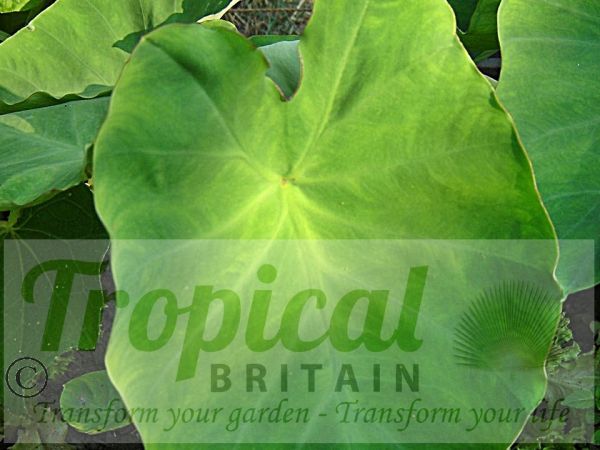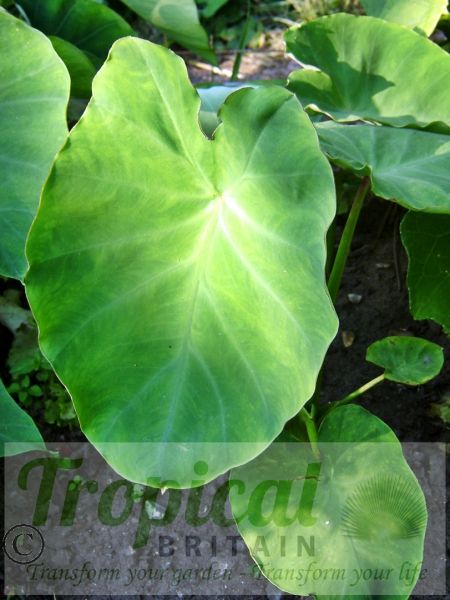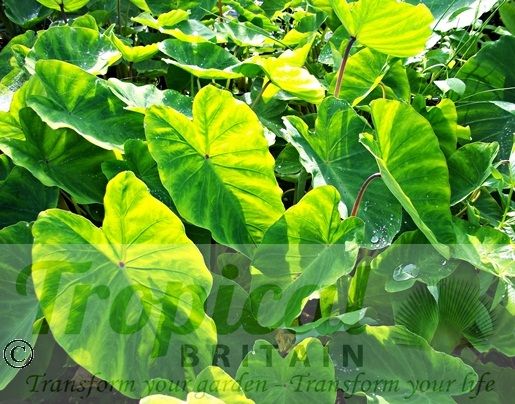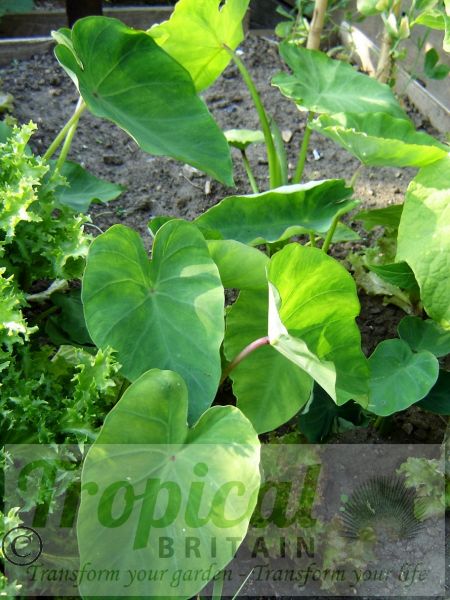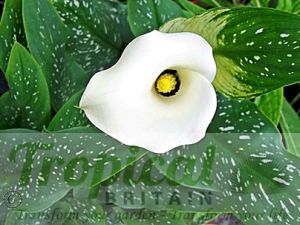Colocasia esculenta, is grown throughout the world primarily for its tubers, which become edible after cooking. Probably originating in Eastern India and the region between Myanmar and Bangladesh, it is one of the major food plants of the world and predated both wheat and rice as a cultivation crop. It is known by many different common names, which include taro, eddo, dasheen and kalo. Colocasia esculenta is an extremely variable species and has many different forms probably because its chromosomes are prone to unpredictable behaviour during cell division. Because of this natural variablilty, many different cultivars have arisen. Different regions produce many different types and even within one type there can be a marked variablity over the course of a season or two. The two prominent chromosome numbers in Colocasia esculenta are 2n=28 and 2n=42: the diploids with 2n=28 chromosomes being mainly Colocasia esculenta var esculenta genotypes characterised by a large central tuber surrounded by smaller ones. This type is generally refered to as Dasheen, itself a transliteration of the French phrase, "de Chine" - from China. The other cytotype is the triploid with 2n=42 chromosomes, Colocasia esculenta var antiquorum, the eddo or eddoe, which is characterised by relatively smaller central tubers and well developed side tubers. It is not surprising that such a polymorphic plant has created a certain amount of debate and its taxonomy is complex.
It is usually grown in the exotic garden for its large ornamental leaves which have a quintessentially tropical look. It enjoys full sun in the growing season and plenty of water. Its natural habitat is flowing water rather than stagnant water and in warmer parts of the world has become naturalised along riverbanks and watercourses. It is relatively easy to grow in the UK during the summer months. It is also relatively easy to help them through the British winter but a little care and common sense is required. In my experience it is best to lift the tubers before the frosts arrive. Otherwise, at the end of the growing season, its leaves and stems will be turned to a mushy gel in the first frost. If you live in a relatively mild area, and the soil is well-mulched and not too water-logged then you may wish to experiment leaving the tubers in the ground over winter. But, if your area is too cold - and that is most of the British Isles - it is much better to lift the tubers and store them in a dry, frost-free space ready to plant again in the spring just as you would for dahlias or cannas. Alternatively, if you have the room indoors, keep them growing in a warm atmosphere like your bathroom or kitchen windowsill over the winter months. Lower light levels however can make them look a little sad and you will have to resist the temptation to putting them outside too early as a late frost will put you back to square one.
There is off course another option - eat them !! I grew up eating taro and for me they are a natural food. They are highly nutritious and contain vitamins C and E, potassium, magnesium, and folate. The molecules of starch in the corms are extremely small making them very easy to digest. All the dread warnings I read about cooking them properly tend to make me smile. Yes, they do contain calcium oxalate crystals - raphides - and yes, if you were mad enough to eat them raw it would taste like swallowing broken glass. But even I am not that mad. Most of the raphides are just under the skin. Peel the roots wearing gloves. You can also rub oil over your hands to prevent them getting itchy while you peel them and then wash them afterwards. Either way is good. Then boil them well and flavour with salt and lemon juice - delicious! Or very lightly mash them so that they are still a bit chunky and fry them with onion, garlic and chilli. Serve with lime juice. They are also great with coconut milk. The variety offered here is perfectly edible and, as I say, delicious. And then you don't have to worry about overwintering them - just grow some more the next year!
Additional Information
| Order | Alismatales |
|---|---|
| Family | Araceae |
| Sub-Family | Aroideae |
| Synonyms | Colocasia acris, Colocasia antiquorum, Colocasia antiquorum var. acris, Colocasia antiquorum var. aquatilis, Colocasia antiquorum var. esculenta, Colocasia antiquorum var. euchlora, Colocasia antiquorum var. fontanesii, Colocasia antiquorum var. globulifera, Colocasia antiquorum var. illustris, Colocasia antiquorum var. nymphaeifolia, Colocasia antiquorum var. typica, Colocasia esculenta var. acris, Colocasia esculenta var. aquatilis, Colocasia esculenta var. fontanesii, Colocasia esculenta var. globulifera, Colocasia esculenta var. illustris, Colocasia esculenta var. typica, Colocasia esculenta var. euchlora, Colocasia euchlora, Colocasia fontanesii, Colocasia himalensis, Colocasia nymphaeifolia, Colocasia peregrina, Colocasia vulgaris, Alocasia dussii, Alocasia illustris, Arum chinense, Arum colocasia, Arum colocasioides, Arum esculentum, Arum nymphaeifolium, Arum peltatum, Caladium acre, Caladium colocasia, Caladium esculentum, Caladium nymphaeaefolium, Caladium violaceum, Calla gaby |
| Geographical Origin | Worldwide throughout the tropics, probably originating in Eastern India and the region between Myanmar and Bangladesh |
| Cultivation | Warm sunny position with ample water in the summer. Lift the tubers for storage over winter |
| Eventual Height | 60-70 cm |
| Eventual Spread | 50 cm |
| Hardiness | Tender |
-
Nice plantVery heathy, good looking plant - many thanks
Posted on
-
Looks very goodI've got it in my out building which will be above 3,4 centigrade all winter, so lets see what it does until May when it goes out.
Looks very good.Posted on
-
Good valueNice plant received in excellent condition.
Posted on

Free DELIVERY
ON ALL ORDERS OVER £99THIS OFFER IS VALID ON ALL OUR STORE ITEMS.

